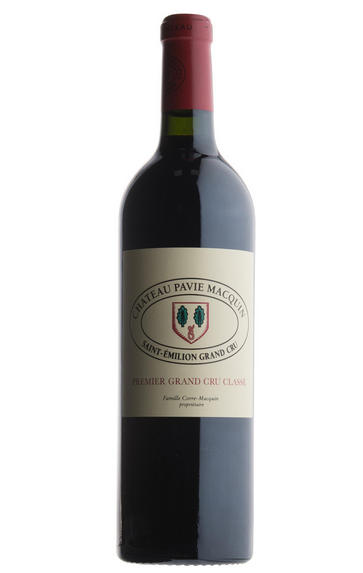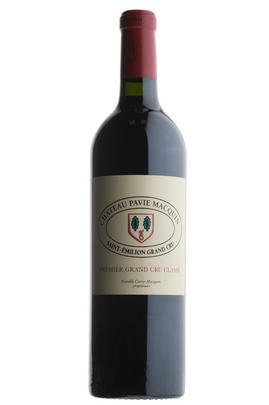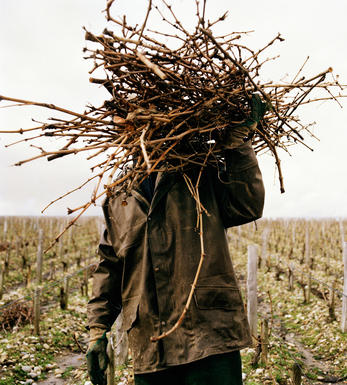
2008 Château Pavie Macquin, St Emilion, Bordeaux

Critics reviews
Robert M. Parker, Jr. - 02/05/2011
(Jancis Robinson MW - jancisrobinson.com - Apr 09)
Consultants Nicolas Thienpont and Stephane Derenoncourt have produced a beautiful St.-Emilion that tastes like the quintessence of crushed rocks intermixed with blueberry, blackberry, black raspberry, liquorice, camphor and truffle notes. This full-bodied effort should drink well in 4-5 years, and last for two decades or more. It achieved 14.5% natural alcohol.
(Robert Parker- Wine Advocate- May 2011)
. It is another superb effort from this property that was elevated to premier grand cru classe status until a judge in Libourne, for unknown reasons, threw out the classification, a decision beyond belief, that is now under appeal.
A number of exceptional wines have emerged from Pavie Macquin, which is managed by Nicolas Thienpont and Stephane Derenoncourt, and the 2008 boasts a whopping 14.5% natural alcohol, higher than in 2005, 2000, or 1998. While extremely high in tannin and very unevolved, for those with patience and cold cellars, or who plan to pass on their wines to their children, this is a worthwhile choice.
It is that backward, concentrated, and impressive. It exhibits a black/purple colour in addition to stunning notes of graphite, black fruits, underbrush, chocolate, and roasted coffee beans. Full-bodied, powerful, and rich, the high but sweet tannins, combined with the freshness of the acids make for a remarkably youthful, nuanced wine that should easily age for three decades.
(Robert Parker- Wine Advocate- April 2009)
About this WINE

Chateau Pavie Macquin
Château Pavie Macquin, a St Emilion Premier Grand Cru Classé (B), is a property that has hit form in the last 10 years and is now producing first-class wines. It is located east of the village of St Emilion and its 15 hectares of vineyards are located on the Côte Pavie, adjacent to the vineyards of Pavie, Pavie-Decesse and Troplong-Mondot. Since 1990 Nicholas Thienpoint Château has been in charge of the property. A pioneer of the Right Bank, Nicolas Thienpoint first pushed the boundaries with organic then biodynamic winemaking in developing the property’s style, helped by his soon-to-be-famous maître de chai, Stéphane Derenoncourt, who joined the team in 1990 and still consults today. Pavie Macquin's wine is a blend of 70% Merlot, 25% Cabernet Franc and 5% Cabernet Sauvignon.

St Émilion
St Émilion is one of Bordeaux's largest producing appellations, producing more wine than Listrac, Moulis, St Estèphe, Pauillac, St Julien and Margaux put together. St Emilion has been producing wine for longer than the Médoc but its lack of accessibility to Bordeaux's port and market-restricted exports to mainland Europe meant the region initially did not enjoy the commercial success that funded the great châteaux of the Left Bank.
St Émilion itself is the prettiest of Bordeaux's wine towns, perched on top of the steep limestone slopes upon which many of the region's finest vineyards are situated. However, more than half of the appellation's vineyards lie on the plain between the town and the Dordogne River on sandy, alluvial soils with a sprinkling of gravel.
Further diversity is added by a small, complex gravel bed to the north-east of the region on the border with Pomerol. Atypically for St Émilion, this allows Cabernet Franc and, to a lesser extent, Cabernet Sauvignon to prosper and defines the personality of the great wines such as Ch. Cheval Blanc.
In the early 1990s there was an explosion of experimentation and evolution, leading to the rise of the garagistes, producers of deeply-concentrated wines made in very small quantities and offered at high prices. The appellation is also surrounded by four satellite appellations, Montagne, Lussac, Puisseguin and St. Georges, which enjoy a family similarity but not the complexity of the best wines.
St Émilion was first officially classified in 1954, and is the most meritocratic classification system in Bordeaux, as it is regularly amended. The most recent revision of the classification was in 2012

Cabernet Sauvignon Blend
Cabernet Sauvignon lends itself particularly well in blends with Merlot. This is actually the archetypal Bordeaux blend, though in different proportions in the sub-regions and sometimes topped up with Cabernet Franc, Malbec, and Petit Verdot.
In the Médoc and Graves the percentage of Cabernet Sauvignon in the blend can range from 95% (Mouton-Rothschild) to as low as 40%. It is particularly suited to the dry, warm, free- draining, gravel-rich soils and is responsible for the redolent cassis characteristics as well as the depth of colour, tannic structure and pronounced acidity of Médoc wines. However 100% Cabernet Sauvignon wines can be slightly hollow-tasting in the middle palate and Merlot with its generous, fleshy fruit flavours acts as a perfect foil by filling in this cavity.
In St-Emilion and Pomerol, the blends are Merlot dominated as Cabernet Sauvignon can struggle to ripen there - when it is included, it adds structure and body to the wine. Sassicaia is the most famous Bordeaux blend in Italy and has spawned many imitations, whereby the blend is now firmly established in the New World and particularly in California and Australia.


Buying options
Add to wishlist
Description
Richness combined with a sense of terroir has fast become Ch. Pavie Macquin’s trademark style and the 2008 is no exception. Plush fruit from the 85% Merlot is superbly balanced by refreshing acidity from the 14% Cabernet Franc and 1% Cabernet Sauvignon.
Nicolas Thienpont says that the dry weather after 10th September “saved the vintage” and he could well be right. What he omits to mention is that excellent viticultural decisions and superb winemaking skills are also responsible for creating a wonderful wine with layers of chocolaty complexity and a very rewarding finish. Bravo, Nicolas.
wine at a glance
Delivery and quality guarantee